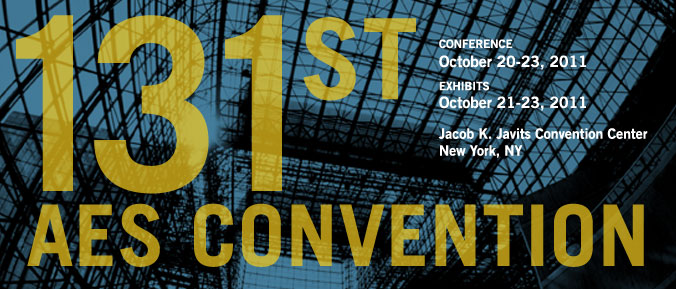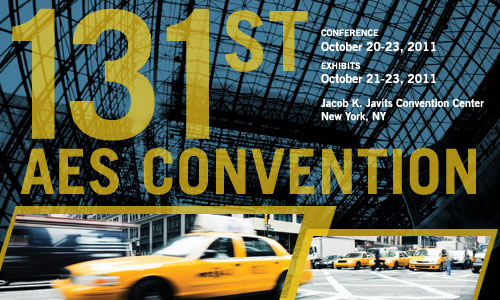
AES New York 2011
Paper Session P22
P22 - Listening Tests
Sunday, October 23, 9:00 am — 12:30 pm (Room: 1E09)
Chair:
Duncan Williams, University of Oxford - Oxford, UK
P22-1 Comparison of Subjective Assessments Obtained from Listening Tests through Headphones and Loudspeaker Setups—Vincent Koehl, Mathieu Paquier, University of Brest (UEB) - Plouzané, France; Simeon Delikaris-Manias, National Engineering School of Brest (UEB) - Plouzané, France
Sound reproduction over headphones is, because of its convenience, indifferently used to reproduce and assess a large variety of audio contents. Nevertheless, it is not yet proven that differences between sound sequences are equally perceived when played back through headphones as using dedicated loudspeaker systems. This study aims at evaluating whether differences and preferences between excerpts are equally perceived using these two reproduction methods. Various types of audio contents, issued by two different recording systems, were then to be compared on both headphones and loudspeaker setups. The results indicate that the two reproduction methods provided consistent similarity and preference judgments. This suggests that the features involved in similarity and preference assessments were preserved when reproducing these excerpts over headphones.
Convention Paper 8560 (Purchase now)
P22-2 A Subjective Validation Method for Musical Instrument Emulation—Leonardo Gabrielli, Stefano Squartini, Università Politecnica delle Marche - Ancona, Italy; Vesa Välimäki, Aalto University - Espoo, Finland
This paper deals with the problem of assessing the distinguishability between the sound generated by an acoustical or electric instrument and an algorithm designed to emulate its behavior. To accomplish this, several previous works employed subjective listening tests. These are briefly reviewed in the paper. Different metrics to evaluate test results are discussed as well. Results are reported for listening tests performed on the sound of the Clavinet and a computational model aimed at its emulation. After discussing these results a guideline for subjective listening tests in the field of sound synthesis is proposed to the research community for further discussion and improvement.
Convention Paper 8561 (Purchase now)
P22-3 Exploratory Studies on Perceptual Stationarity in Listening Tests—Part I: Real World Signals from Custom Listening Tests—Max Neuendorf, Fraunhofer Institute for Integrated Circuits IIS - Erlangen, Germany; Frederik Nagel, International Audio Laboratories - Erlangen, Germany, Fraunhofer Institute for Integrated Circuits IIS, Erlangen, Germany
Many recent publications related to audio coding use the recommendation "MUltiple Stimuli with Hidden Reference and Anchor" (MUSHRA; ITU-R BS.1534-1) for the evaluation of subjective audio quality. Judging the quality of multiple conditions can be inconclusive if the employed test excerpts exhibit more than one prevalent artifact. Two papers investigate the impact of time varying artifacts in both, synthetic and real world signals and claim "perceptual stationarity" as a requirement for test sequences used in MUSHRA tests. This first part deals with commonly used test signals. These often have a length of 10 to 20 seconds and frequently contain time varying perceptual artifacts. Ratings of those items are compared to ratings of cutouts that are predominantly perceptually stationary over time.
Convention Paper 8562 (Purchase now)
P22-4 Exploratory Studies on Perceptual Stationarity in Listening Tests—Part II: Synthetic Signals with Time Varying Artifacts—Frederik Nagel, Fraunhofer Institute for Integrated Circuits IIS - Erlangen, Germany, International Audio Laboratories Erlangen, Erlangen, Germany; Max Neuendorf, Fraunhofer Institute for Integrated Circuits IIS - Erlangen, Germany
Many recent publications related to audio coding use the recommendation "MUltiple Stimuli with Hidden Reference and Anchor" (MUSHRA; ITU-R BS.1534-1) for the evaluation of subjective audio quality. Judging the quality of multiple conditions can be inconclusive if the employed test excerpts exhibit more than one prevalent artifact. Two papers investigate the impact of time varying artifacts in both, synthetic and real world signals and claim "perceptual stationarity" as a requirement for test sequences used in MUSHRA tests. This second part focuses on the alternation of multiple types of artifacts in one item and the differences in the ratings compared to items which only contain one of the respective types. It furthermore discusses the meaning of the temporal position of artifacts in an item.
Convention Paper 8563 (Purchase now)
P22-5 The Practical Effects of Lateral Energy in Critical Listening Environments—Richard King, Brett Leonard, McGill University - Montreal, Quebec, Canada, Centre for Interdisciplinary Research in Music, Media and Technology, Montreal, Quebec, Canada; Grzegorz Sikora, McGill University - Montreal, Quebec, Canada
Limited information exists on the practical effects of lateral reflections in small rooms design for high-quality sound reproduction and critical listening. A study is undertaken to determine what affect specular and diffuse lateral reflections have on a trained listener. A task-based methodology is employed in which a highly trained subject is asked to perform a task commonly seen in their daily work. The physical conditions of the listening environment are altered to minimize, maximize, and diffuse side-wall reflections. Results correlate the presence of strong lateral energy with an initial reduction of subjects’ ability to complete the task within normal tolerances, but adaptation soon occurs, restoring the subjects to practically normal pace and accuracy.
Convention Paper 8565 (Purchase now)
P22-6 The Effects of Monitoring Systems on Balance Preference: A Comparative Study of Mixing on Headphones versus Loudspeakers—Richard King, Brett Leonard, McGill University - Montreal, Quebec, Canada, Centre for Interdisciplinary Research in Music, Media and Technology, Montreal, Quebec, Canada; Grzegorz Sikora, McGill University - Montreal, Quebec, Canada
The typical work-flow of the modern recording engineer often necessitates the use of a number of different monitoring systems over the course of a single project, including both loudspeaker-based systems and headphones. Anecdotal evidence exists that suggests different outcomes when using headphones, but there is little quantified, perceptually-based data to guide engineers in the differences to expect when working between monitoring systems. By conducting controlled, in situ measurements with recording engineers performing mixing tasks on both headphones and loudspeakers, the practical effects of both monitoring systems are shown.
Convention Paper 8566 (Purchase now)
P22-7 The Effect of Head Movement on Perceived Listener Envelopment and Apparent Source Width—Anthony Parks, Jonas Braasch, Rensselear Polytechnic Institute - Troy, NY, USA
This study investigates the effect of head movement in the evaluation of LEV and ASW under 15 different concert hall conditions simulated over eight loudspeakers using Virtual Microphone Control. The conditions consist of varying ratios of front-to-back energy and varying levels of cross-correlated reverberant energy. Head movements are monitored in terms of angular rotation using a head tracker while listeners are prompted to assign subjective ratings of LEV and ASW. The tests are repeated while listeners are asked to keep their heads fixed. Head movements are analyzed and results of the tests are compared.
Convention Paper 8567 (Purchase now)
Information Last Updated: 20111005, mei

